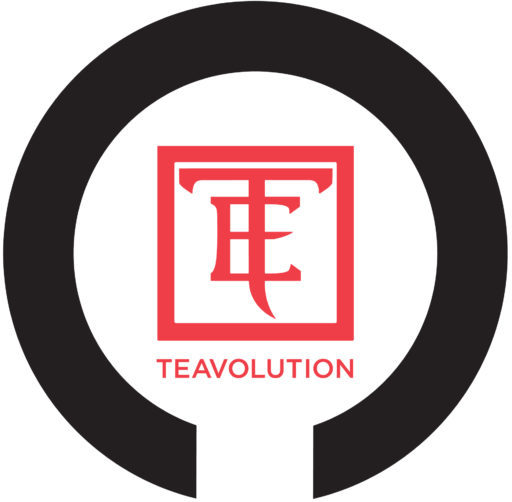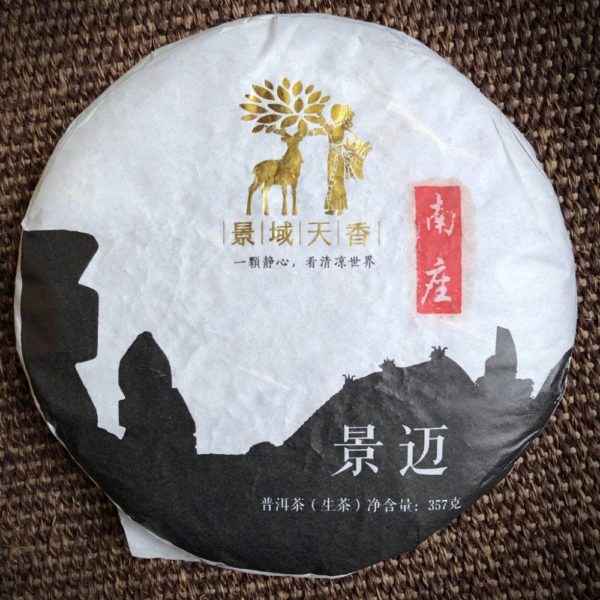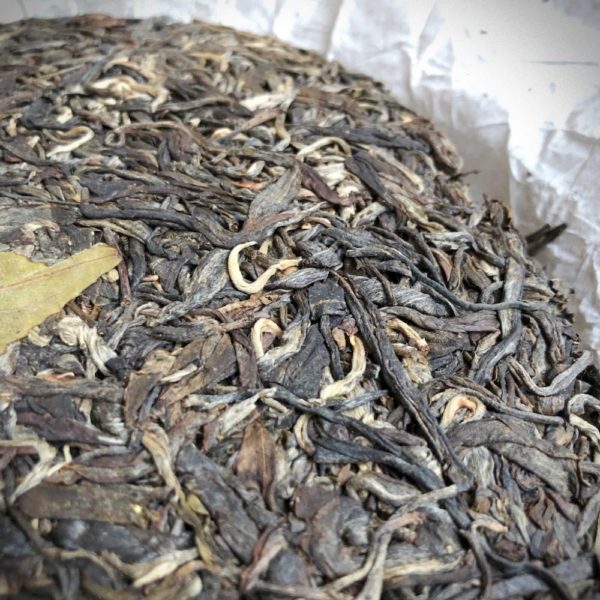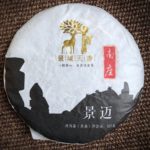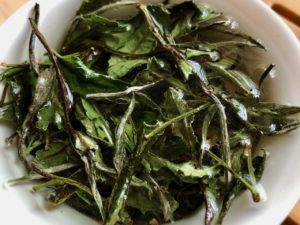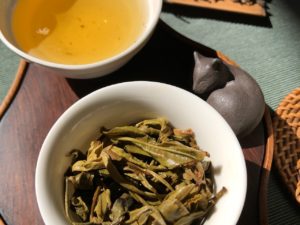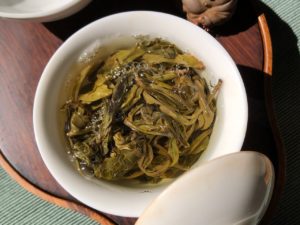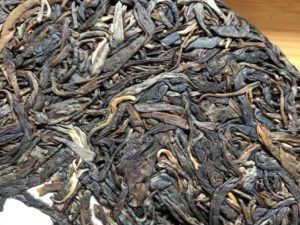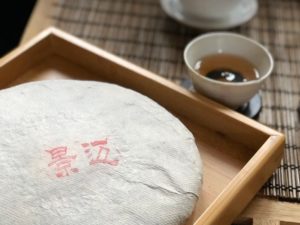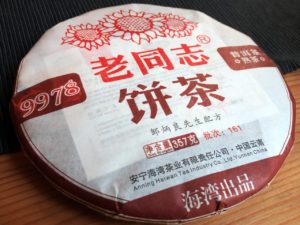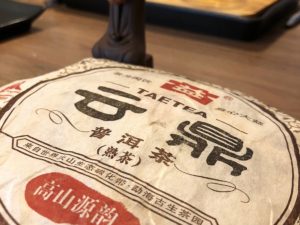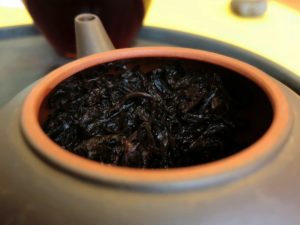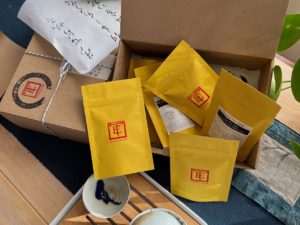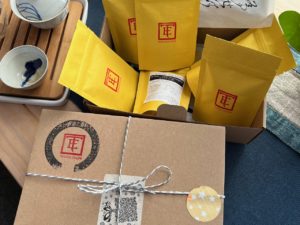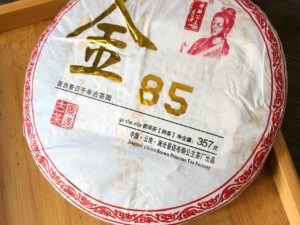Nanzuo Village Old Shengtai 2016
The tea plants are around 50 years old, a natural tea garden. For the tea, the raw material was used in a combination of one bud and two leaves.
Ms. Zhang selected the oldest natural tea gardens in her village to make this tea. She worked with her husband in her tea factory in Nanzuo village. Located 10 km from the main village of Jingmai, the village has unique climatic conditions that are different from the rest of the Jingmai Mountains.
The leaves are long, the tea disc has a loose structure.
Pleasant, easy to drink, it is halfway between everyday and festive teas. It has a sweet character and is characterized by a slight tartness, which is a good carrier of mild tobacco and fruity vegetable flavors. Interestingly, the wake-up water is now sweet, as if it were sugar. In the aftertaste, the character of wild flower honey also appears, I would call it a spicy tea.
It was pressed into 357 gr disks.
Jingmai - mountain story
Jingmai Mountain is famous for its huge ancient tea gardens. However, two-thirds of the cultivated area is occupied by younger plantations, so-called natural tea gardens. The first plantations of this kind were planted in the 1970s around Jingmai. In this era, the main goal was to increase production; tea had to be cheap to make it affordable for the masses.
At the time, these new plantations were seen as an improvement over the ancient tea gardens. They were chemically fertilized and protected from insects and diseases with pesticides; weeds were controlled with herbicides and tea picking was faster than ever thanks to well-pruned picking tables at the top of the tea trees.
At that time, Pu-erh tea was not considered an exceptional product. It was everyday tea, blended and pressed in a few county-sized factories; only a few different tea discs were available each year. Therefore, the logic behind the establishment of these gardens in Jingmai was clear: to modernize tea garden management techniques, taking advantage of Jingmai's high elevation and the necessary expertise of the locals in tea cultivation and processing. The green revolution started in Jingmai.
The tea grown in the Jingmai plantations was particularly fragrant and praised by the large tea factories in Menghai and Lancang. At that time, many tea plantations flourished in Jünnan; this was supported by slow price increases and general domestic consumption growth. From 2003 to 2007, the "Puer boom" led to an increase in the area of tea plantations, every mountain wanted to produce more tea, more and more tea traders drove straight to the mountains and wanted a ton of the famous Puer tea.
In 2007, the market crashed and the tea world realized that this growth was only a brief episode in the larger story of Puer tea. The price of tea from old plants has increased over the years because this raw material cannot be produced again. The production of Puer tea in Yunnan has increased several times compared to the level of ten years ago. Despite the increase in demand, the price of tea did not rise; the competition was too strong in the low-end market.
A New Hope…
At that time, the local government decided to convert the traditional tea plantations of Jingmai Mountain into so-called "natural tea gardens", or Shengtai Cha Yuans in Chinese. The project aims to reduce the use of fertilizers and pesticides, reduce the density of plantations by cutting 5 out of 4 tea trees and planting shade trees in the tea gardens. This project officially started in 2010 and has been quite successful. Through local control and financial incentives, local people changed their techniques and since then the use of pesticides has decreased dramatically.
The natural tea gardens of Jingmai Mountain are not organic. Tea growers can spray herbicides, usually when they don't have time to do mechanical weeding; however, spraying insecticides or fungicides is subject to local government approval and would be done collectively. We know that pests and diseases are rare these days, why is that?
The decision to cut down 80% of the tea trees on tea plantations may seem crazy; however, the goal was to have space between each tree. In a traditional tea plantation, the trees are so close together that the picking tables form a carpet. This makes the entire tea garden much more vulnerable to the spread of pests and diseases, which is why such gardens most often need chemical control. In Jingmai's natural tea gardens, the space between individual tea trees creates a buffer that slows the spread of insects.
In addition, the planting of shade trees and the absence of insecticides create a favorable habitat for spiders. These natural predators provide additional protection against pests and diseases in tea gardens. As shade trees grow, they provide more and more ecological services: they limit sunlight, regulate temperature, reduce weeds, provide firewood for cooking and tea processing, introduce organic matter, pump nutrients into the deeper layers of the soil, and provide more comfortable conditions for tea pickers. 🙂 .
Finally, limiting fertilization to once every two years limits growth and increases quality.
Good decision?
The impact on yield was severe, but in the current situation the trade-off was largely worth it. Low-quality tea is not for sale; Jingmai strives for an image of excellence, and the quality of leaves from young tea gardens has improved since the introduction of the new policy. The price of fresh leaves has quadrupled since 2010, and Jingmai is not struggling to sell the tea crop.
